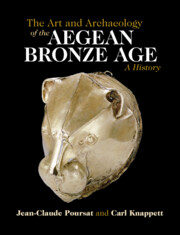Book contents
- The Art and Archaeology of the Aegean Bronze Age
- The Art and Archaeology of the Aegean Bronze Age
- Copyright page
- Contents
- Figures
- Introduction
- Part I Aegean Neolithic Art
- Part II The Art of the Aegean Early Bronze Age
- Part III Aegean Art in the Cretan First Palace Period
- Part IV Aegean Art in the Second Palace Period
- Part V Aegean Art in the Cretan Second Palace Period
- Part VI Aegean Art in the Final Palatial Period of Knossos
- Part VII Aegean Art of the Mainland Mycenaean Palatial Period
- Part VIII Aegean Art at the End of the Bronze Age
- Chapter 50 Artworks in Context
- Chapter 51 Architecture at the End of the Bronze Age
- Chapter 52 Figures, Figurines, and Anthropomorphic and Zoomorphic Vases
- Chapter 53 Jewellery and Metalwork
- Chapter 54 Pictorial Art and Vase Painting
- Chapter 55 Mycenaean Art and Its Legacy
- Afterword Aegean Art Through Forgers’ Eyes
- References
- Index
- Plate Section (PDF Only)
- References
Chapter 51 - Architecture at the End of the Bronze Age
from Part VIII - Aegean Art at the End of the Bronze Age
Published online by Cambridge University Press: 19 May 2022
- The Art and Archaeology of the Aegean Bronze Age
- The Art and Archaeology of the Aegean Bronze Age
- Copyright page
- Contents
- Figures
- Introduction
- Part I Aegean Neolithic Art
- Part II The Art of the Aegean Early Bronze Age
- Part III Aegean Art in the Cretan First Palace Period
- Part IV Aegean Art in the Second Palace Period
- Part V Aegean Art in the Cretan Second Palace Period
- Part VI Aegean Art in the Final Palatial Period of Knossos
- Part VII Aegean Art of the Mainland Mycenaean Palatial Period
- Part VIII Aegean Art at the End of the Bronze Age
- Chapter 50 Artworks in Context
- Chapter 51 Architecture at the End of the Bronze Age
- Chapter 52 Figures, Figurines, and Anthropomorphic and Zoomorphic Vases
- Chapter 53 Jewellery and Metalwork
- Chapter 54 Pictorial Art and Vase Painting
- Chapter 55 Mycenaean Art and Its Legacy
- Afterword Aegean Art Through Forgers’ Eyes
- References
- Index
- Plate Section (PDF Only)
- References
Summary
On the mainland it is the palatial sites of the previous period that we know most about. Recent excavations have shown that, at least in the Argolid, at Mycenae, Tiryns, and Midea, fortifications were repaired and citadels continued to be occupied. At Tiryns, Building T, an assembly hall for the community, replaces the grand palatial megaron on the upper citadel (J. Maran, AA 2000, 1–16; J. Maran, in Laffineur and Hägg 2001, 113–22); it is built on the spot where the Throne Room was previously. It consists of two rooms, a vestibule to the south and an elongated room to the north, divided by a row of columns (AE2, fig. 338); the central hearth has gone. In the great court, a platform replaces the old circular altar. At Midea, the new structure that replaces the old megaron also has a central row of columns (G. Walberg, Aegean Archaeology 2, 1995, 87–91).
- Type
- Chapter
- Information
- The Art and Archaeology of the Aegean Bronze AgeA History, pp. 491 - 494Publisher: Cambridge University PressPrint publication year: 2022

